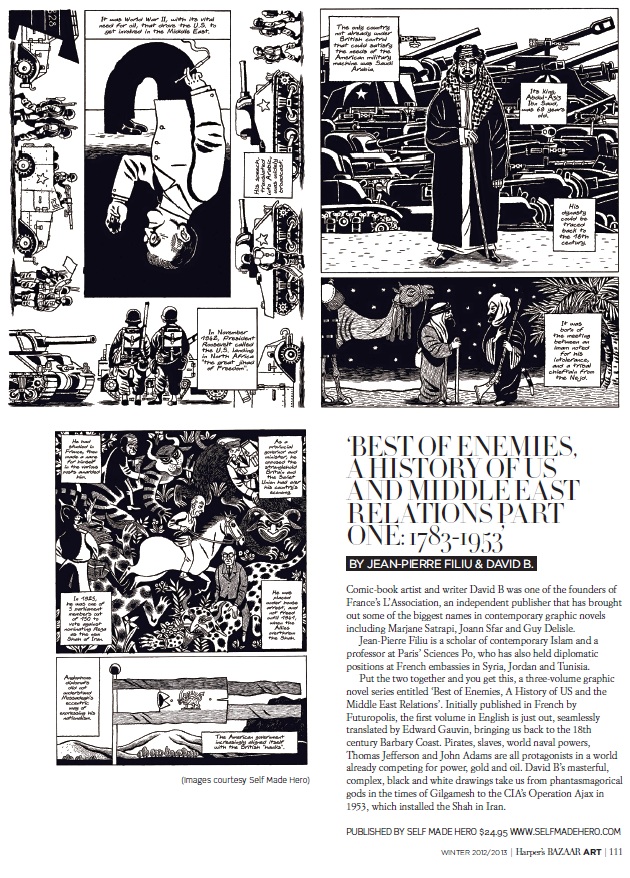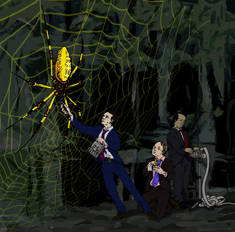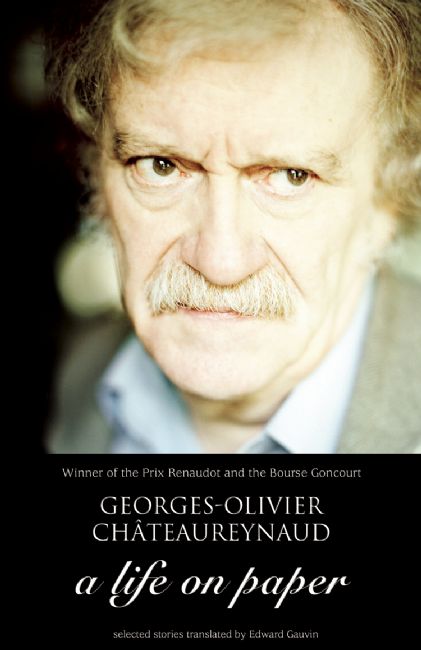Under the editorship of Olivia Snaijie, the Winter 2012-2013 issue of Harper’s Bazaar ART, an Arabian sister publication, generously affords a full page to a review of David B. and Jean-Pierre Filiu’s Best of Enemies, including the kindest of nods to my translation:
Best of Enemies in Harper’s Bazaar ART
January 27th, 2013 § 0 comments § permalink
Sharaz-de: Tales from the Arabian Nights
January 19th, 2013 § 0 comments § permalink
Italian comics master Sergio Toppi passed away in August. In December, Archaia released his first work in English, Sharaz-De, a retelling of the Thousand and One Arabian nights. It may seem odd that for a book of overwhelming visual appeal I’m going to do a largely imageless post, but the blog coverage has been so thorough that it’s a job best left to them. So please click through to be dazzled!
First, a preface from Illustrators’ Lounge apropos his passing:
Milanese illustrator Sergio Toppi began his career in advertising but by 1966 had moved into comics. Toppi accumulated a tremendous body of work during his career include titles such as Collezionista (“Collectorâ€), Linus, Corto Maltese and many one-shot comics during his long-term collaboration with writer Il Giornalino. His style is unmistakeable, geometrically dominated with loose sketchy pencil work. A fantastic amalgamation of tone, patterns and texture.
At Comics Bulletin Jason Sacks has only the highest praise:
The word “visionary” is sometimes thrown around too liberally in the arts. I often find myself using the term to describe a creator whose work is just a bit different from the mainstream, innovative in small but interesting ways that move their medium ahead, or to the side, or at a distinct angle, but still within comfortable confines. It takes a certain kind of artist to reveal to me what it means to be a true visionary in the comics field.
Sergio Toppi is a true visionary, and his Sharaz-De: Tales from the Arabian Nights is a true visionary work. In all my years reading comics I’ve never read something quite as unique, odd and intriguing as this book.
The encomium continues in detail with Greg Burgas of Comic Book Resources:
It’s Toppi’s magnificent artwork, however, that makes this a must-buy. Walt Simonson wrote the foreword to this book, and it’s not surprising that Simonson writes about how much he loves Toppi’s work – Toppi is obviously a big influence in Simonson’s art. I don’t even know if I can write about his artwork well enough to do it justice. Toppi is amazingly detailed, as the desert world in which the book is set comes to magnificent life under his pen, and his use of swirling lines make it even more Asiatic and lustrous. This is an “Orientalist,†archaic view of the Arab world, but it’s still marvelous. Toppi’s characters are bold and striking, with a mixture of Semitic and African characteristics, and Toppi adorns them in gorgeous robes and armor and headgear that turn them into gods on earth, easily able to contend with the demons and djinn who also populate the book. He uses negative space beautifully, and his page compositions are superb – he uses panels, but he also often blends several scenes together in one splash page that remain remarkably easy to read. His creatures are beautiful – enormous and occasionally grotesque, but also marvelously ornate and perfectly suited for the magical world that Sharaz-De embroiders every night. Toppi experiments with some colors in the book, and those are wonderful, too – deep blues and purples and greens turn the desert at night into a mystical place, while the rich browns and yellows of the clothing during the day make the characters almost a part of the landscape. It’s an amazingly sensual book, packed with precise details and expansive vistas and fierce characters, and perhaps the only one who comes close in American comics is Simonson himself.
Publishers Weekly echoes these sentiments:
Two chapters are given over to vibrant watercolors, adding a psychedelic undertone to the tightly woven ink work elsewhere, as jinn, devils, and selfish men do battle upon the pages. Toppi does not use conventional comic panels, but allows his illustrations to sprawl behind and around them, with a singular illustration depicting multiple aspects of the story depending on where your eye first lands. A foreword from Walter Simonson pays tribute to the artist, who died in August, 2012. The Tales from the Arabian Nights may be well enough known, but Toppi’s unparalleled skill at twisting fine art, design, and comic book structure together render this a real treat.
And in the most recent review, Scott Vanderploeg of Comic Book Daily concurs:
Of course one look at the images included and you’ll see it’s Toppi’s art that steals the show. It’s beautifully done, detailed and immersive. The layout and design of the pages provide so much detail to the tale that it’s hard to tear yourself away to turn the page. Everything flows seamlessly, no matter what aspect of graphic storytelling used.
Bernard Quiriny in Subtropics 9
March 2nd, 2010 § 0 comments § permalink
The latest issue of Subtropics is now available for purchase and perusal online and in print (at discerning periodical purveyors nationwide), featuring my translation of Belgian Bernard Quiriny’s “A Guide to Famous Stabbings†from his debut collection Fear of the First Line (Phebus, 2005). The entire story is also available online at the journal’s website, where you’ll also find in English and the original French an interview the author graciously agreed to give, wherein he muses on sundry topics of interest including author Enrique Vila-Matas, the writing process, other stories and characters from the collection, what it means to be a Belgian Francophone writer, and the Belgian fantastical tradition known as the Belgian School of the Bizarre.
Comments welcome from any and all readers, who may wonder on the basis of this story that I characterize Quiriny as a fabulist. Without referring to other stories that would vindicate the appellation beyond doubt, I would say only this: Borges ventures that “at least one of the following four elements must be present in a narrative for it to be fantastic: 1) contamination of reality by dream, 2) a work of art within a work of art, 3) travel in time rather than in space, and 4) the presence of a doppelganger.”
Slowly, Through Select Testimonies
December 23rd, 2009 § 0 comments § permalink
to its advent–for example, here and here–a book long merely dream or rumor is becoming printed fact:
“Then English and French and mere Spanish will disappear from the globe. The world will be Tlön.” ~ J.L.B.
World Fantasy Con… some overdue wrap-up
November 9th, 2009 § 0 comments § permalink
Before any more time goes by—yikes, it’s been a week already!—some afterthoughts on WFC. The blogosphere, ADD as it is, has long ago up and moved on, and everyone else has filed their reports and coverage. So please indulge me three quick posts pertaining thereto. First, huge congrats to all this year’s nominees and winners at World Fantasy Con!
- Lifetime Achievement: Ellen Asher & Jane Yolen
- Best Novel (tie): The Shadow Year, Jeffrey Ford (Morrow) & Tender Morsels, Margo Lanagan (Allen & Unwin; Knopf)
- Best Novella: “If Angels Fightâ€, Richard Bowes (F&SF 2/08)
- Best Short Story: “26 Monkeys, Also the Abyssâ€, Kij Johnson (Asimov’s 7/08)
- Best Anthology: Paper Cities: An Anthology of Urban Fantasy, Ekaterina Sedia, ed. (Senses Five Press)
- Best Collection: The Drowned Life, Jeffrey Ford (HarperPerennial)
- Best Artist: Shaun Tan
- Special Award – Professional: Kelly Link & Gavin J. Grant (for Small Beer Press and Big Mouth House)
- Special Award – Non-Professional: Michael Walsh (for Howard Waldrop collections from Old Earth Books)
Another round of applause from this section for my former teacher Jeffrey Ford, and the publishers of my upcoming translation of Georges-Olivier Châteaureynaud’s stories, Kelly Link & Gavin J. Grant. And w00t for the Paper Cities upset!
Two Lines 2009: Wherever I Lie Is Your Bed
November 9th, 2009 § 0 comments § permalink

The latest incarnation of the annual Two Lines anthology from the Center for the Art of Translation is now out, available from Amazon and the Center itself. The cover is a marvel to behold. Inside, the book features the work of such poets and writers as Günter Grass, Adonis, Jose Manuel Prieto, George Szirtes, and Yoko Tawada, and such translators as Breon Mitchell, Esther Allen, Susan Bernofsky, Alison Anderson, and Karen Emmerich. The guest editors are the illustrious Margaret Jull Costa and Marilyn Hacker. It also includes a nifty two-pager by the incredible French comics artist François Ayroles, translated by yours truly. Because Chad Post is Chad Post, he already has a review up at Three Percent.
I would be remiss not adding that this lovely cover, which has caused acquaintances to fondle the book covetously, was the brainchild and handiwork of editor Annie Janusch, who does double world lit duty as the Works-In-Translation editor of The Quarterly Conversation. She’s been my point person at CAT for the last two years, and made the experience of contributing to Two Lines pleasurable and professional. Wouldn’t have happened without her. Three cheers!
This handsome volume fêtes its official launch on the following occasion (wish I could be there):
Monday, November 9: Book Release Party at LIMN Gallery » Read the rest of this entry «
Foreign Correspondents: October in Words Without Borders
October 1st, 2009 § 0 comments § permalink
Two new pieces up in the Words Without Borders “Foreign Correspondents†issue this month, one by Gébé and the other by François Vallejo. Gébé, a satirist after my own heart, looks into the mysterious activities of the International Bureau for Front Location, while Vallejo chronicles the 1988 fire that consumed the Chiado district of Lisbon.
Editorial cartoonist Gébé’s piece, featuring a short introduction by yours truly, is taken from his prose collection Not-Quite-Botched Dispatches (But a Hard Sell for the Nightly News), originally Reportages pas vraiment ratés mais difficile à vendre à France Soir, reprinted in 2001 by Le Diléttante (that last link for readers of French).
The excerpt by François Vallejo is the opening to his 2008 novel The Burning of the Chiado (L’Incendie du Chiado) from Éditions Viviane Hamy.
Check’em out!
Imaginales & Interfictions 2
June 26th, 2009 § 2 comments § permalink
I’m a month late in mentioning the 8th annual Imaginales “Festival of Imaginary Worlds†in Épinal (best known for a printmaker that’s sort of the Currier & Ives of France), but luckily enough this year has seen an explosion of a English language blog coverage: Hal Duncan, Cheryl Morgan, and David Anthony Durham especially provide detailed accounts and fun photos. (The con site itself has an English version that, where tourism sites are concerned, only slightly smacks of wonky Anglicization. Monsieur gets to say that ‘coz he’s a snobby translator très littéraire.)
Among the stories nominated for the Prix Imaginales in the Best Short Fiction category were Kelly Link’s “Stone Animals†and two nouvelles by Lionel Davoust. One of these, “L’Île close,†a meta-Arthurian fantasia, took home the prize–CONGRATULATIONS–and will be appearing (translated by yours truly, with wonderful advice from editor Delia Sherman and all this despite the author’s fluency in English) in the Interstitial Arts Foundation’s fall anthology Interfictions 2. Ah yes, this post had you fooled at first, but it is in fact a shill. By hook or by crook, I always end up pushing a book. Which leads us to this shout-out from the IAF:
Support Interfictions 2!
 We live in a world of niche marketing. The Interstitial Arts Foundation brings artists together to tear those barriers down.
We live in a world of niche marketing. The Interstitial Arts Foundation brings artists together to tear those barriers down.
We are asking you now to join us in our next adventure in storming the barricades: Interfictions 2: a New Anthology of Interstitial Writing, edited by Delia Sherman & Christopher Barzak. Interfictions 2 will be published in November 2009 in collaboration with Small Beer Press.
The first volume of Interfictions, published in 2007, was hailed as “A phenomenal collection…engrossing and provocative†(Hipster Bookclub) that “belongs on the nightstand of anyone interested in the development of contemporary short fiction†(Atlanta Journal-Constitution).
This second volume features original work by a whole new set of writers who joyfully explore the big imaginative spaces between conventional genres. And this time, we’ll be reaching out to even more readers by publishing a series of free stories on the new Interfictions 2 Annex online!
What can you do to help? This extraordinary collection of interstital fiction needs your financial support. We’re asking you to sponsor not just a book, but an idea – the idea that artists need to be able to express themselves freely and directly to their audiences, without the restraints of conventional genre limitations.
Here are some ways you can help us publish Interfictions 2: » Read the rest of this entry «
Translation and Interpretation
June 24th, 2009 § 0 comments § permalink
Recently, translating a pay piece I didn’t pick, I had what seemed like some new thoughts on an old translator’s conundrum: to alter or not to alter. I tend to take fewer liberties with pieces I don’t pick, because the voice may not speak to me; it’s a glove I don more gingerly. Strange, that interpret should have two meanings and translate only one, and that one imply a one-to-one mapping, as in, “That doesn’t translate.†The professional sense of the terms are still widely confused, and most people (who, on learning what I do for a living, ask “Oh! Have you tried working for the UN?â€) still use them interchangeably, but the distinction seems obvious once drawn—translators write (ghostwrite) and interpreters speak (are ventriloquized); both channel, paraphrase, yet I found myself tempted to tell an editor who asked for sentences somewhat freighted and opaque in an original to be further elucidated, “My job is to translate, not interpret the text.†That is, although the act of translation is one of comprehension, of explaining a text to oneself (indeed, as all reading is the rescuing, mining, or recovery of meaning from a text into one’s own private unarticulated language; to that translation adds periphrasis in a communal tongue) it seems the final translation should not go further in the direction of explication than allowed for in the original. » Read the rest of this entry «
Cf. Amoureux
June 24th, 2009 § 1 comment § permalink
“Être aimé n’entraînait aucun devoir et donnait tous les droits, aimer ne conférait que le droit de souffrir.” ~ Georges-Olivier Châteaureynaud, L’Autre rive
“Aimer sans retour, c’est admettre qu’on se jettera dans le feu pour quelqu’un si l’occasion s’en présente, et que ce sacrifice nous vaudra trois secondes de reconnaissance, suivies d’un oubli pur et simple. Si béjaune qu’on soit, on comprend que l’autre s’accommode fort bien de nos tourments et que la vie lui demeure douce même quand elle nous devient insupportable.” ~ Georges-Olivier Châteaureynaud, Le Château de verre
“Quand on est aimé, on ne doute de rien, quand on aime, on doute de tout.” ~ Colette



